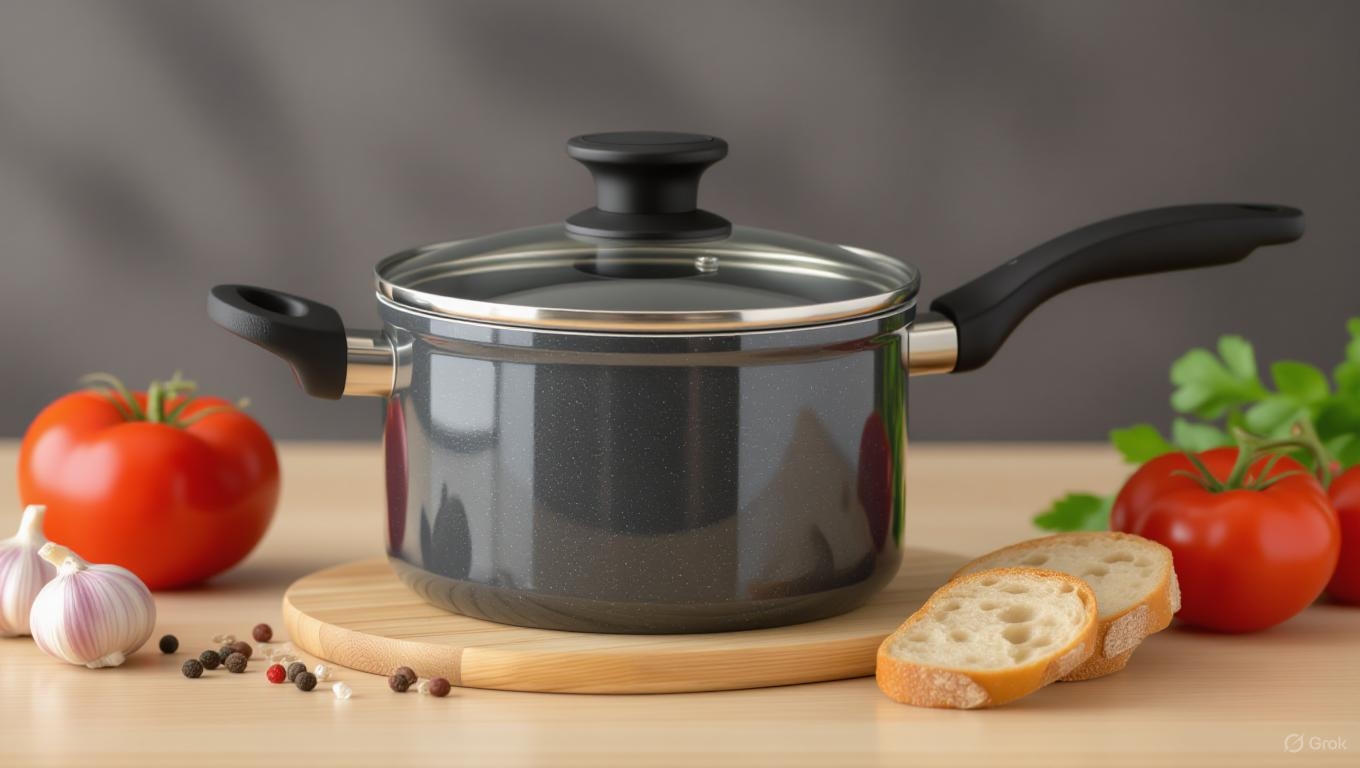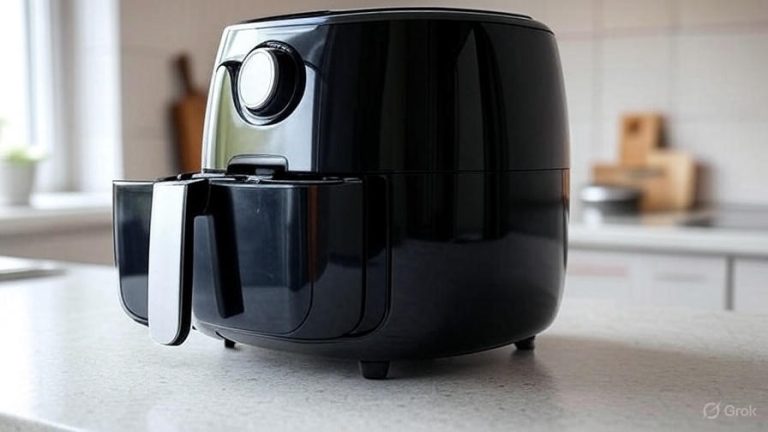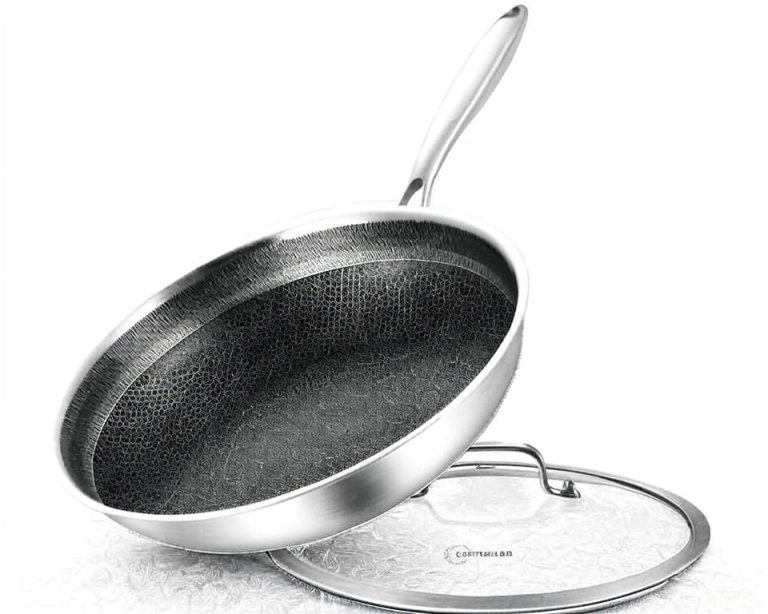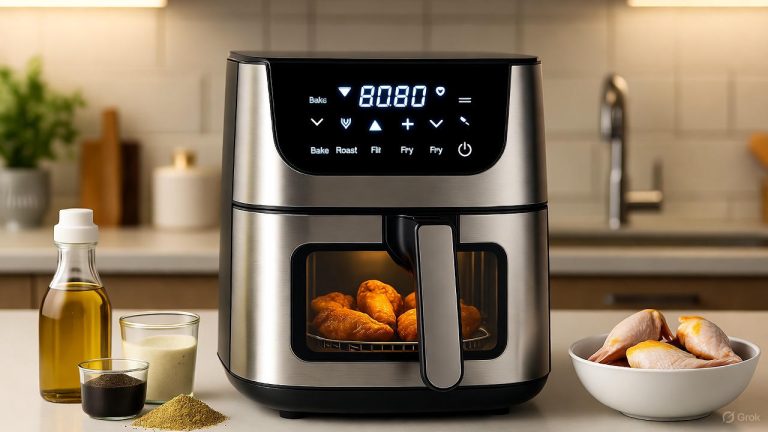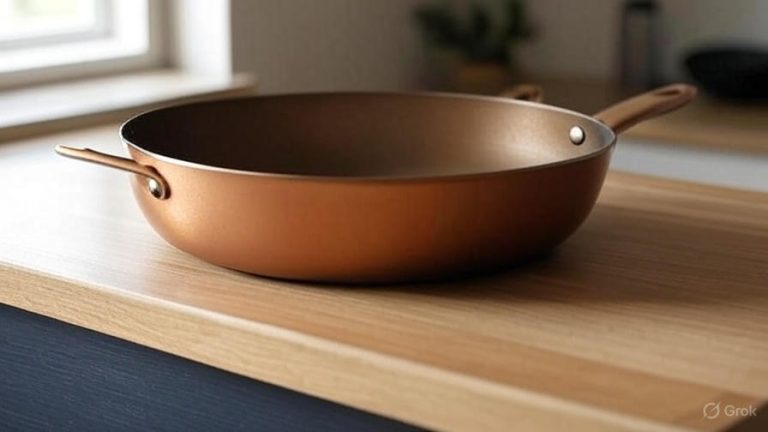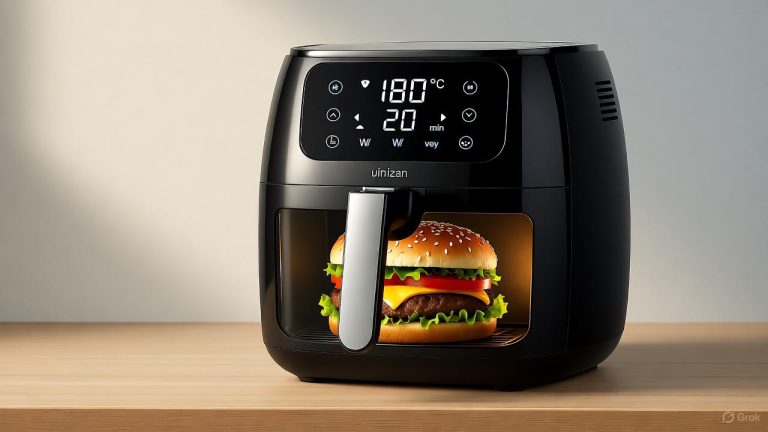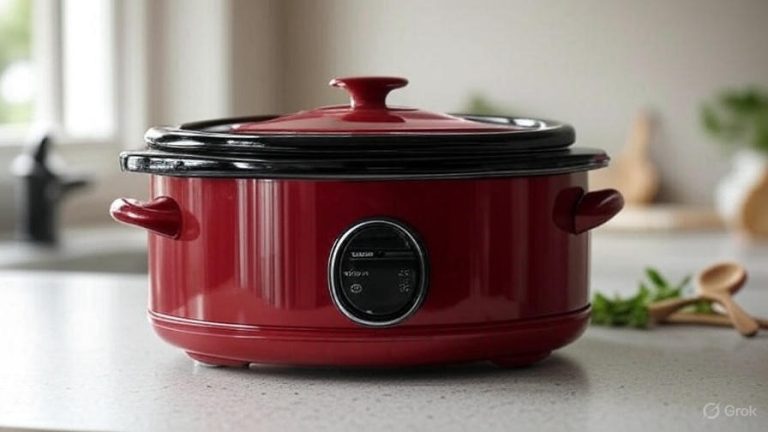5 Best 3 Quart Saucepan In 2025
A quality 3-quart saucepan serves as the workhorse of every well-equipped kitchen. This versatile cookware handles everything from simmering delicate sauces to cooking pasta for small families. Professional chefs and home cooks alike rely on these medium-sized pans for daily cooking tasks.
After extensive testing and evaluation, we’ve identified five exceptional 3-quart saucepans that deliver outstanding performance across different cooking styles and budgets. Each model brings unique strengths to the kitchen, from superior heat distribution to innovative nonstick coatings.
Why Size Matters: The 3-Quart Sweet Spot
The 3-quart capacity hits the perfect balance between functionality and storage efficiency. This size accommodates most cooking tasks without overwhelming smaller stovetops or kitchen cabinets. Home cooks find this capacity ideal for preparing side dishes, reheating leftovers, and creating signature sauces.
Restaurant kitchens often stock multiple 3-quart saucepans because they handle medium-volume preparations efficiently. The size works brilliantly for cooking rice, steaming vegetables, making soups, and reducing stocks. Professional culinary schools recommend this capacity as essential cookware for developing fundamental cooking techniques.
Essential Features That Define Excellence
Heat distribution stands as the most critical factor in saucepan performance. Superior models distribute heat evenly across the bottom surface, preventing hot spots that can scorch delicate ingredients. Aluminum cores and copper bases excel at conducting heat uniformly throughout the cooking surface.
Handle design significantly impacts user experience and safety. Ergonomic handles stay cool during cooking while providing secure grip control. Riveted handles offer superior durability compared to welded attachments, withstanding heavy daily use in demanding kitchen environments.
Lid functionality affects cooking efficiency and moisture retention. Well-fitted lids create proper seals for steaming and simmering. Transparent glass lids allow visual monitoring without releasing steam, while stainless steel lids reflect heat back into the pan for faster cooking times.
Top 5 Best 3-Quart Saucepans: Complete Reviews
1. Cuisinart 6193-20 Chef’s Classic Non-Stick Hard-Anodized Saucepan

The Cuisinart Chef’s Classic represents exceptional value engineering in professional-grade cookware. Hard-anodized aluminum construction provides superior heat conduction while creating an incredibly durable cooking surface. The dark exterior finish resists scratching and maintains its appearance through countless cooking sessions.
Quantalon nonstick interior coating delivers reliable food release performance without excessive oil or butter. This proprietary surface handles delicate proteins and sticky sauces with minimal cleanup effort. The coating maintains its nonstick properties through proper care and moderate heat applications.
The solid stainless steel handle features an ergonomic design that stays comfortably cool during stovetop cooking. Riveted construction ensures long-term durability under heavy kitchen use. The handle angle provides excellent leverage for stirring thick mixtures and pouring hot liquids safely.
Tight-fitting stainless steel lid traps heat and moisture effectively. The lid design creates proper steam circulation for even cooking results. Drip-free pouring becomes effortless thanks to the precision-engineered rim design.
Performance Highlights:
- Even heat distribution eliminates hot spots
- Nonstick surface requires minimal oil
- Comfortable grip reduces hand fatigue
- Dishwasher-safe construction simplifies cleanup
Potential Drawbacks:
- Nonstick coating requires careful temperature control
- Dark exterior shows water spots easily
- Not compatible with metal utensils
2. SENSARTE Nonstick Sauce Pan with Swiss Granite Coating
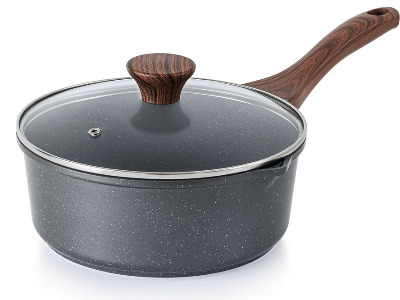
SENSARTE brings innovative Swiss granite coating technology to affordable home cooking. The unique mineral-based surface combines nonstick convenience with exceptional durability. This coating system resists chipping, scratching, and thermal shock better than traditional nonstick surfaces.
Double spout design sets this saucepan apart from conventional models. The dual pouring channels accommodate both left and right-handed users while providing precise liquid control. This feature proves invaluable when transferring hot soups, sauces, and pasta water.
Aluminum base construction ensures rapid, even heating across the entire cooking surface. The thick bottom prevents warping on high-heat cooking surfaces while maintaining flat contact with induction cooktops. Heat spreads uniformly, preventing scorching of temperature-sensitive ingredients.
Bakelite handle incorporates heat-resistant properties that keep the grip cool during extended cooking sessions. The ergonomic shape fits comfortably in various hand sizes while providing secure control. Handle attachment uses sturdy riveting for long-term reliability.
Performance Highlights:
- PFOA-free coating ensures safe cooking
- Dual spouts accommodate all pouring angles
- Induction compatible base works on all cooktops
- Granite coating resists wear and staining
Potential Drawbacks:
- Lighter construction feels less substantial
- Handle design may not suit all preferences
- Requires hand washing for best coating longevity
3. Farberware Classic Stainless Steel Sauce Pan
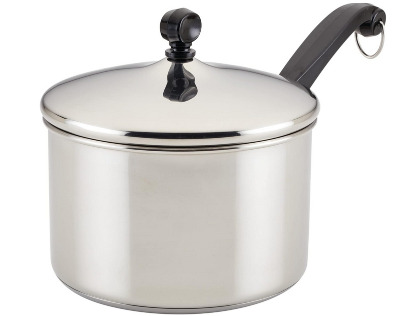
Farberware Classic embodies traditional cookware craftsmanship with modern performance standards. Full stainless steel construction creates a completely non-reactive cooking environment suitable for all ingredients. The polished finish maintains its lustrous appearance through decades of regular use.
Aluminum disc base technology combines the heat conduction benefits of aluminum with stainless steel durability. This tri-ply construction prevents hot spots while providing rapid temperature response. The base remains flat and stable across all cooktop types including induction surfaces.
Phenolic handle design incorporates heat-resistant materials that stay cool during stovetop cooking. The comfortable grip shape reduces hand strain during extended stirring and mixing tasks. Solid construction withstands the demands of busy kitchen environments.
Stainless steel lid creates an effective seal for moisture retention and even cooking. The mirror-polished surface reflects heat back into the pan for improved efficiency. Precision manufacturing ensures proper lid-to-rim fit without gaps or warping.
Performance Highlights:
- Dishwasher-safe stainless steel simplifies maintenance
- Non-reactive surface works with acidic ingredients
- Tri-ply base provides excellent heat distribution
- Classic design complements any kitchen decor
Potential Drawbacks:
- Requires oil or butter to prevent sticking
- Shows fingerprints and water spots readily
- Heavier weight compared to aluminum alternatives
4. MICHELANGELO Thick Bottom Stainless Steel Saucepan
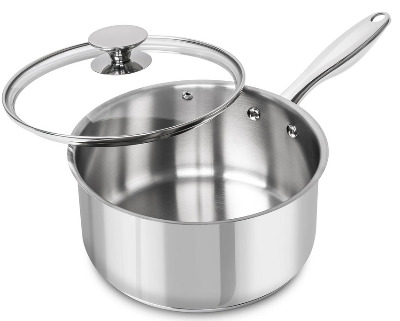
MICHELANGELO focuses on thick-bottom construction that delivers restaurant-quality heat distribution. The reinforced base prevents warping while providing superior thermal mass for consistent cooking temperatures. This design approach works exceptionally well for slow simmering and delicate sauce preparations.
Five-layer impact-bonded base combines aluminum core with stainless steel layers for optimal performance. The thick construction eliminates hot spots while maintaining precise temperature control. Heat spreads evenly from edge to edge, ensuring uniform cooking results every time.
Ergonomic stay-cool handle incorporates thoughtful design elements that enhance user comfort. The grip angle reduces wrist strain during stirring motions while providing secure control over heavy loads. Riveted attachment ensures dependable performance through years of kitchen service.
Premium stainless steel construction creates a completely safe, non-reactive cooking environment. The polished interior surface develops natural nonstick properties through proper seasoning and use. This traditional approach provides lifetime durability without coating concerns.
Performance Highlights:
- Thick bottom prevents burning and hot spots
- Impact-bonded construction ensures even heating
- Induction compatible design works on all cooktops
- Premium stainless steel resists corrosion and staining
Potential Drawbacks:
- Higher price point than basic models
- Requires proper preheating technique
- Heavier construction may not suit all users
5. HexClad Hybrid Nonstick 3-Quart Saucepan
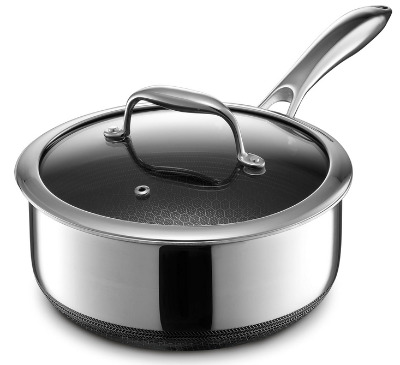
HexClad revolutionizes cookware design with patented hybrid technology that combines nonstick convenience with stainless steel durability. The unique hexagonal pattern creates elevated stainless steel peaks surrounded by nonstick valleys. This innovative surface allows metal utensil use while maintaining excellent food release properties.
Tri-ply construction features aluminum core sandwiched between stainless steel layers. This design provides rapid, even heat distribution while creating induction compatibility. The base remains perfectly flat across all cooktop surfaces, ensuring consistent contact and heating efficiency.
Stay-cool handle design incorporates advanced materials that resist heat transfer from the cooking surface. The ergonomic shape provides comfortable grip control during extended cooking sessions. Oven-safe construction handles temperatures up to 900°F for versatile cooking techniques.
Tempered glass lid allows visual monitoring without releasing steam or heat. The precision-fit design creates proper sealing for effective braising and simmering. Stainless steel rim adds durability while maintaining attractive appearance.
Performance Highlights:
- Metal utensil safe hybrid surface
- Dishwasher-friendly construction
- Extreme oven-safe temperature rating
- Lifetime warranty demonstrates quality confidence
Potential Drawbacks:
- Premium pricing reflects advanced technology
- Unique surface requires learning curve
- Heavier weight compared to traditional nonstick
Material Science: What Makes Each Pan Unique
Stainless steel construction provides the most durable and versatile cooking surface available. This non-reactive material works safely with acidic ingredients like tomatoes and citrus without affecting flavor. Professional kitchens prefer stainless steel for its longevity and ability to develop natural nonstick properties through proper seasoning.
Hard-anodized aluminum offers superior heat conduction while creating an incredibly hard, scratch-resistant surface. The electrochemical process transforms regular aluminum into a material that rivals stainless steel in durability. This treatment also creates a naturally nonstick surface without chemical coatings.
Modern nonstick coatings incorporate advanced polymer technology that delivers exceptional food release properties. PFOA-free formulations ensure safe cooking while maintaining nonstick performance through proper care. Granite-based coatings provide enhanced durability compared to traditional polymer surfaces.
Hybrid technology combines multiple materials to capture the benefits of each component. Stainless steel provides durability and metal utensil compatibility while nonstick areas deliver easy cleanup. This approach represents the cutting edge of cookware innovation.
Heat Distribution: The Foundation of Great Cooking
Even heat distribution separates professional-grade cookware from basic kitchen tools. Superior saucepans eliminate hot spots that can burn delicate sauces or scorch ingredients. Thick bases and aluminum cores conduct heat uniformly across the entire cooking surface.
Thermal mass affects how cookware responds to temperature changes. Heavier construction maintains steady temperatures during cooking while preventing sudden temperature spikes. This thermal stability proves crucial for techniques like caramel making and chocolate tempering.
Induction compatibility requires ferromagnetic materials in the base construction. Modern saucepans incorporate stainless steel bases or magnetic discs to work efficiently with induction cooktops. This compatibility ensures the cookware works across all heating methods.
Handle Design: Comfort Meets Safety
Ergonomic handle design directly impacts cooking comfort and safety. Well-designed handles stay cool during stovetop cooking while providing secure grip control. The angle and shape should accommodate different hand sizes and cooking techniques.
Heat-resistant materials prevent burns during extended cooking sessions. Bakelite, phenolic resins, and specialized stainless steel alloys resist heat transfer from the pan body. Stay-cool technology allows confident handling without oven mitts during stovetop cooking.
Attachment methods determine long-term durability and safety. Riveted handles provide superior strength compared to welded connections. The attachment points should remain secure through thermal expansion and repeated heating cycles.
Lid Performance: Sealing in Flavor and Efficiency
Proper lid fit creates effective seals for steaming, braising, and simmering techniques. Well-engineered lids trap moisture and heat while allowing controlled steam release. The rim-to-lid interface should create consistent contact around the entire circumference.
Material choices affect lid performance and durability. Stainless steel lids reflect heat back into the pan while resisting warping. Tempered glass allows visual monitoring without lifting the lid and releasing heat. Both materials offer distinct advantages for different cooking applications.
Knob design influences ease of use and oven safety. Heat-resistant materials prevent burns during lid removal. Ergonomic shapes provide secure grip even with wet hands. Some designs incorporate venting features for controlled steam release.
Maintenance and Care: Protecting Your Investment
Proper cleaning techniques extend cookware life while maintaining optimal performance. Stainless steel benefits from immediate cleaning to prevent staining and mineral buildup. Gentle detergents and soft cleaning tools preserve surface finishes without scratching.
Nonstick surfaces require careful handling to maintain their food release properties. Hand washing with mild detergents protects coating integrity better than aggressive dishwasher cycles. Avoiding extreme temperatures prevents coating degradation and extends usable life.
Storage practices prevent damage during cabinet storage. Nested storage should include protective padding between pan surfaces. Hanging storage eliminates stacking pressure while keeping cookware easily accessible.
Price vs. Performance: Finding Your Sweet Spot
Budget considerations balance initial cost against long-term value. Premium cookware often provides superior performance and durability that justifies higher prices. The cost per use calculation helps evaluate true value over the cookware’s lifespan.
Performance priorities vary among different cooking styles and skill levels. Professional chefs may prioritize heat distribution and durability over nonstick convenience. Home cooks often value ease of cleanup and versatile functionality.
Warranty coverage reflects manufacturer confidence in product quality. Lifetime warranties indicate superior construction and materials. Limited warranties may suggest planned obsolescence or quality compromises.
Cooking Technique Compatibility
Sauce making benefits from even heat distribution and temperature control. Quality saucepans prevent scorching while allowing precise temperature adjustments. The cooking surface should respond quickly to heat changes for optimal sauce consistency.
Pasta cooking requires adequate capacity and efficient heat transfer. The 3-quart size accommodates most pasta portions while maintaining proper water-to-pasta ratios. Rapid heating reduces cooking time and energy consumption.
Vegetable preparation varies from quick sautéing to slow braising. Versatile saucepans handle both high-heat searing and gentle simmering effectively. The cooking surface should accommodate different oil types and temperature ranges safely.
Professional Kitchen Standards
Commercial kitchen demands exceed typical home cooking requirements. Professional-grade saucepans withstand constant use, high temperatures, and aggressive cleaning protocols. Restaurant equipment standards emphasize durability, efficiency, and safety.
Volume cooking requires consistent performance across large batches. Quality saucepans maintain even heating regardless of load size or cooking duration. Temperature recovery after adding cold ingredients separates professional equipment from home-grade alternatives.
Safety standards in commercial kitchens mandate specific handle designs and construction methods. Riveted handles and balanced weight distribution prevent accidents during busy service periods. Heat-resistant materials reduce burn risks during high-volume cooking.
Innovation in Modern Cookware
Hybrid technology represents the latest advancement in cookware engineering. This approach combines the benefits of different materials and surface treatments. The result delivers enhanced performance while addressing traditional cookware limitations.
Coating technology continues advancing with improved durability and safety profiles. Mineral-based coatings provide nonstick properties without traditional polymer concerns. These surfaces resist scratching while maintaining food release performance through extended use.
Manufacturing precision affects every aspect of cookware performance. Computer-controlled processes ensure consistent wall thickness and perfect lid fits. Quality control standards eliminate defects that could compromise cooking performance or safety.
Environmental Considerations
Sustainable manufacturing practices reduce environmental impact while maintaining product quality. Responsible sourcing of raw materials supports ethical supply chains. Energy-efficient production methods minimize the carbon footprint of cookware manufacturing.
Cookware longevity directly impacts environmental sustainability. Durable products reduce replacement frequency and associated waste. Quality construction materials enable recycling at the end of product life.
PFOA-free coatings address environmental and health concerns associated with traditional nonstick surfaces. Alternative coating technologies provide similar performance without persistent chemical concerns. This evolution reflects increasing awareness of cookware’s environmental impact.
Expert Recommendations and Final Thoughts
The Cuisinart Chef’s Classic emerges as our top value recommendation for most home cooks. Its combination of performance, durability, and affordability makes it an excellent starting point for serious cooking. The hard-anodized construction provides professional-grade heat distribution at an accessible price point.
SENSARTE offers the best specialized features with its dual-spout design and granite coating. This model suits cooks who prioritize convenience and easy cleanup. The PFOA-free coating provides peace of mind while delivering reliable nonstick performance.
Farberware Classic represents traditional quality that appeals to traditionalists. Its stainless steel construction offers lifetime durability with proper care. This option suits cooks who prefer classic materials and don’t mind learning proper stainless steel cooking techniques.
MICHELANGELO targets serious home cooks who demand professional performance. The thick-bottom construction and premium materials justify the higher price for dedicated cooking enthusiasts. This choice delivers restaurant-quality results in home kitchen environments.
HexClad pushes the boundaries with innovative hybrid technology. This premium option suits early adopters who want the latest cookware advances. The unique surface combines nonstick convenience with stainless steel durability in an unprecedented design.
Making Your Decision
Budget constraints often determine initial cookware selection, but quality should remain a priority consideration. Investing in superior cookware pays dividends through improved cooking results and extended product life. The best saucepan for your kitchen balances performance needs with financial reality.
Cooking frequency affects the importance of durability and ease of maintenance. Daily cooks benefit from nonstick convenience and dishwasher compatibility. Occasional cooks may prioritize versatility and long-term storage characteristics.
Kitchen compatibility includes cooktop type, storage space, and existing cookware collections. Induction users must verify magnetic base construction. Limited storage favors lightweight, nestable designs. Matching aesthetics create cohesive kitchen appearance.
The perfect 3-quart saucepan enhances every cooking experience while providing reliable service through countless meals. These five exceptional models represent the best options available across different price points and performance priorities. Your ideal choice depends on balancing these factors with your specific cooking needs and preferences.

